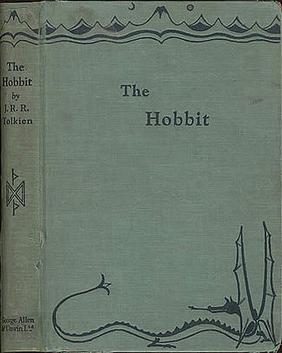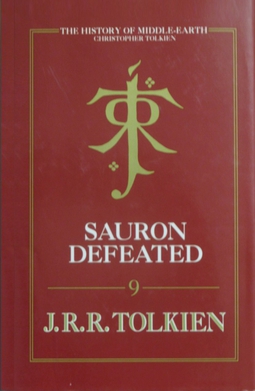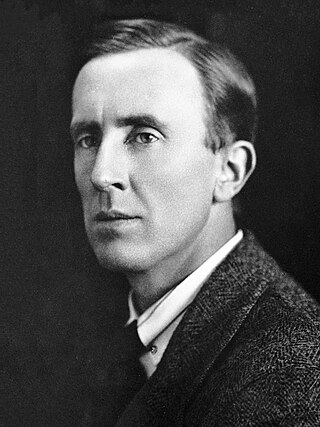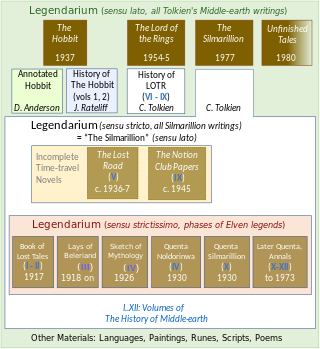Related Research Articles

The Hobbit, or There and Back Again is a children's fantasy novel by the English author J. R. R. Tolkien. It was published in 1937 to wide critical acclaim, being nominated for the Carnegie Medal and awarded a prize from the New York Herald Tribune for best juvenile fiction. The book is recognized as a classic in children's literature and is one of the best-selling books of all time, with over 100 million copies sold.
Bard the Bowman is a character in J. R. R. Tolkien's The Hobbit. A Man of Laketown and a descendant of the ancient Lords of Dale, Bard manages to kill Smaug, the dragon, after which he becomes king of Dale. Tolkien created the character specifically to kill Smaug, since none of the other protagonists of the story were able to fulfill this role. Bard the Bowman may have been inspired by the warrior Wiglaf in the Old English poem Beowulf.

Tom Bombadil is a character in J. R. R. Tolkien's legendarium. He first appeared in print in a 1934 poem called "The Adventures of Tom Bombadil", which also included The Lord of the Rings characters Goldberry, Old Man Willow and the Barrow-wight, from whom he rescues the hobbits. They were not then explicitly part of the older legends that became The Silmarillion, and are not mentioned in The Hobbit.
In the fantasy of J. R. R. Tolkien, the Dwarves are a race inhabiting Middle-earth, the central continent of Arda in an imagined mythological past. They are based on the dwarfs of Germanic myths who were small humanoids that lived in mountains, practising mining, metallurgy, blacksmithing and jewellery. Tolkien described them as tough, warlike, and lovers of stone and craftsmanship.

The History of Middle-earth is a 12-volume series of books published between 1983 and 1996 that collect and analyse much of Tolkien's legendarium, compiled and edited by his son, Christopher Tolkien. The series shows the development over time of Tolkien's conception of Middle-earth as a fictional place with its own peoples, languages, and history, from his earliest notions of a "mythology for England" through to the development of the stories that make up The Silmarillion and The Lord of the Rings. It is not a "history of Middle-earth" in the sense of being a chronicle of events in Middle-earth written from an in-universe perspective; it is instead an out-of-universe history of Tolkien's creative process. In 2000, the twelve volumes were republished in three limited edition omnibus volumes. Non-deluxe editions of the three volumes were published in 2002.

Thomas Alan Shippey is a British medievalist, a retired scholar of Middle and Old English literature as well as of modern fantasy and science fiction. He is considered one of the world's leading academic experts on the works of J. R. R. Tolkien about whom he has written several books and many scholarly papers. His book The Road to Middle-Earth has been called "the single best thing written on Tolkien".
Barrow-wights are wraith-like creatures in J. R. R. Tolkien's world of Middle-earth. In The Lord of the Rings, the four hobbits are trapped by a barrow-wight, and are lucky to escape with their lives; but they gain ancient swords of Westernesse for their quest.

The Round World Version is an alternative creation myth to the version of J.R.R. Tolkien's legendarium as it appears in The Silmarillion and The Lord of the Rings. In that version, the Earth was created flat and was changed to round as a cataclysmic event during the Second Age in order to prevent direct access by Men to Valinor, home of the immortals. In the Round World Version, the Earth is created spherical from the beginning.
The following outline is provided as an overview of and topical guide to the real-world history and notable fictional elements of J. R. R. Tolkien's fantasy universe. It covers materials created by Tolkien; the works on his unpublished manuscripts, by his son Christopher Tolkien; and films, games and other media created by other people.
The term Middle-earth canon, also called Tolkien's canon, is used for the published writings of J. R. R. Tolkien regarding Middle-earth as a whole. The term is also used in Tolkien fandom to promote, discuss and debate the idea of a consistent fictional canon within a given subset of Tolkien's writings.
Middle-earth Enterprises, formerly known as Tolkien Enterprises, is a subdivision of the Embracer Freemode division of Embracer Group and formerly a trade name for a division of The Saul Zaentz Company. The subdivision owns the worldwide exclusive rights to certain elements of J. R. R. Tolkien's two most famous literary works: The Hobbit and The Lord of the Rings. These elements include the names of characters contained within as well as the names of places, objects and events within them, and certain short phrases and sayings from the works.

Tolkien's legendarium is the body of J. R. R. Tolkien's mythopoeic writing, unpublished in his lifetime, that forms the background to his The Lord of the Rings, and which his son Christopher summarized in his compilation of The Silmarillion and documented in his 12-volume series The History of Middle-earth. The legendarium's origins reach back to 1914, when Tolkien began writing poems and story sketches, drawing maps, and inventing languages and names as a private project to create a unique English mythology. The earliest story drafts are from 1916; he revised and rewrote these for most of his adult life.

Tolkien's Legendarium: Essays on The History of Middle-earth is a collection of scholarly essays edited by Verlyn Flieger and Carl F. Hostetter on the 12 volumes of The History of Middle-earth, relating to J. R. R. Tolkien's fiction and compiled and edited by his son, Christopher. It was published by Greenwood Press in 2000. That series comprises a substantial part of "Tolkien's legendarium", the body of Tolkien's mythopoeic writing that forms the background to his The Lord of the Rings and which Christopher Tolkien summarized in his compilation of The Silmarillion.

The History of The Hobbit is a two-volume study of J. R. R. Tolkien's 1937 children's fantasy novel The Hobbit. It was first published by HarperCollins in 2007. It contains Tolkien's unpublished drafts of the novel, with commentary by John D. Rateliff. It details Tolkien's various revisions to The Hobbit, including abandoned revisions for the unpublished third edition of the work, intended for 1960, as well as previously unpublished original maps and illustrations drawn by Tolkien.
Mirkwood is a name used for a great dark fictional forest in novels by Sir Walter Scott and William Morris in the 19th century, and by J. R. R. Tolkien in the 20th century. The critic Tom Shippey explains that the name evoked the excitement of the wildness of Europe's ancient North.
Tolkienmoot is an annual convention run by the Eä Tolkien Society created for scholars, gamers, and enthusiasts of the works of J. R. R. Tolkien. It began under the name of Merpcon in 2005. Always a convention focused on Tolkien scholarly discussion and gaming in Middle-earth, its name was changed in 2009 as the venue expanded. The convention was founded by Hawke Robinson and others.

Richard Carroll West was an American librarian and one of the first Tolkien scholars. He is best known for his 1975 essay on the interlace structure of The Lord of the Rings, for which he won the 1976 Mythopoeic Scholarship Award for Inkling Studies.
J. R. R. Tolkien, the author of the bestselling fantasy The Lord of the Rings, was largely rejected by the literary establishment during his lifetime, but has since been accepted into the literary canon, if not as a modernist then certainly as a modern writer responding to his times. He fought in the First World War, and saw the rural England that he loved built over and industrialised. His Middle-earth fantasy writings, consisting largely of a legendarium which was not published until after his death, embodied his realism about the century's traumatic events, and his Christian hope.
Ancalagon, known as The Black, is a dragon that appears in the legends of British writer J. R. R. Tolkien, and particularly in his novel The Silmarillion.
References
- ↑ McManus, Kelly (November 24, 2007). "Getting to the Bottom of the Hobbit's Tale". The Globe and Mail . p. D25.
- 1 2 Rateliff, John D. "John D. Rateliff's Bio in Brief". Sacnoth's Scriptorium. Retrieved 5 December 2022.
- ↑ Gillespie, Mike (July 29, 2007). "Hot Type: The History of The Hobbit by John D. Rateliff". Ottawa Citizen . p. C3.
- ↑ Anderson, Douglas A. (2009). "John D. Rateliff: A Checklist". Tolkien Studies: An Annual Scholarly Review . 6: 22–26. doi:10.1353/tks.0.0061. S2CID 170130503.
- ↑ "Rings treasures in US library". The Evening Post . January 26, 2002. p. 9.
- ↑ Antlfinger, Carrie (January 27, 2002). "Marquette University Has Tolkien Collection: The University Bought Manuscripts from the British Author". Wisconsin State Journal . p. C6.
- 1 2 3 4 5 Rateliff, John D. (2007). "Mythos (about the Mythos card game)". In Lowder, James (ed.). Hobby Games: The 100 Best . Green Ronin Publishing. pp. 209–212. ISBN 978-1-932442-96-0.
- ↑ "Books by John Rateliff". Alibris.
- ↑ "John D. Rateliff". Pen & Paper. Archived from the original on 4 October 2007.
- ↑ Owchar, Nick (30 December 2007). "Middle-earth evolution". Los Angeles Times . p. R9.
